Introduction
The Barred Owl (Strix varia) is a bird of prey in the Order Strigiformes and the Family Strigidae. This bird of prey is known by many names, and is also called the Hoot Owl or Eight Hooter, and is sometimes mistakenly called the Bard Owl (Lewis, 2017). First spotted on Vancouver Island in the 1960’s, Barred Owls are now a frequent sight among our forests (Nanaimo News).
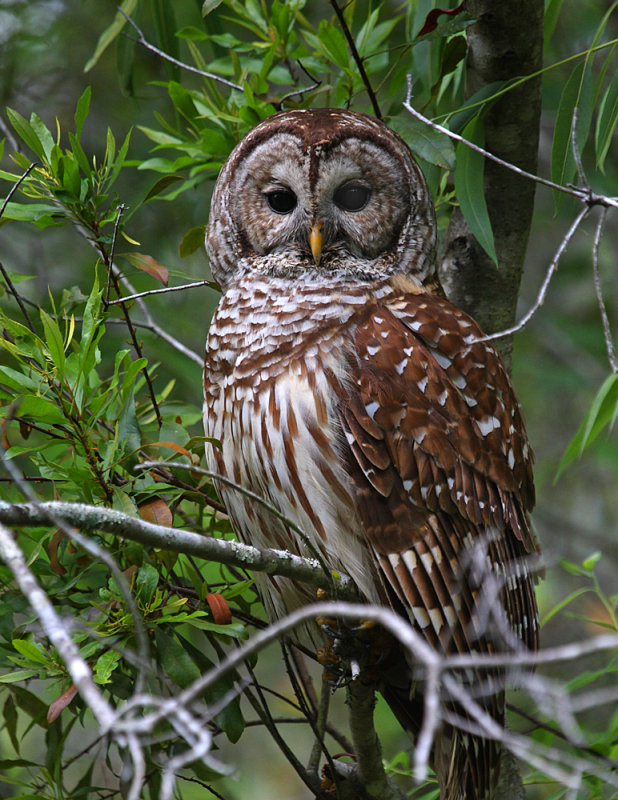
Description and Identification
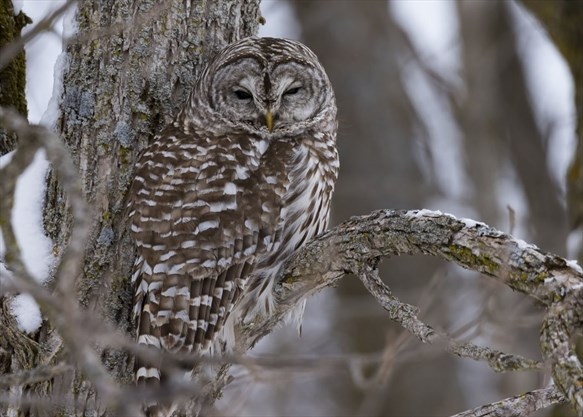
Barred Owls are large owls with a stocky body and round head. Barred Owls lack ear tufts and have large, dark eyes peering out of a round, grey face. As the name suggests, Barred Owls are characterized by horizontal brown and white bars on the wings, tail, and back, with vertical bars on the chest and underside (Cornell University: All About Birds). Their overall mottled appearance allows them to easily blend in with surrounding tree trunks and branches.
Barred Owls can also be identified by their unique calls. Barred owls are highly vocal and have a variety of vocalizations, from yelps and barks to their deep, signature call “hoo, hoo, too-HOO; hoo, hoo, too-HOO, ooo“. This is often phrased as “Who cooks for-you? Who cooks for-yooooou?” and can be heard in many forested areas, primarily after dusk (Lewis, 2017). Calls are often heard in bouts of eight, hence the nickname Eight Hooter. It is difficult to distinguish between the sexes of Barred Owls, but a seasoned birder may be able to distinguish a male’s deeper call from that of a female (Lewis, 2017). Although Barred Owls are most active at night, they are known to call throughout the day as well (Audubon).
Behaviour
Barred Owls are primarily active at night, dawn, and dusk, hunting small mammals, reptiles, amphibians, birds, and invertebrates (Cornell University: Birds of North America). Their preferred method of hunting, called the “perch and pounce” method, includes perching up high and waiting for prey to come to them, from which they will swoop down on silent wings and ambush their prey (About Owls: Owl Research Institute). During the day, you may find them perched among dense foliage, roosting close to a tree trunk and occasionally, hunting or calling.
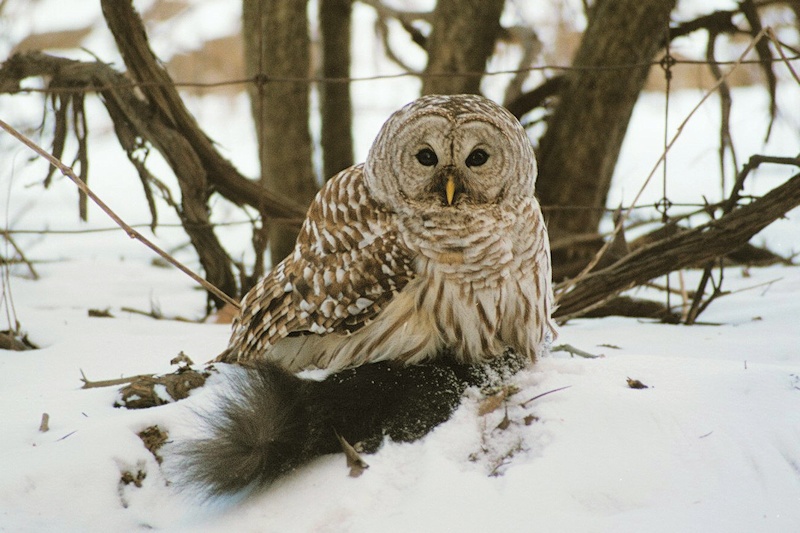
As territorial birds, they mostly vocalize to defend their territory. While not as aggressive as Great Horned Owls, Barred Owls are still very protective of their nests, and may chase or strike intruders while hooting (Audubon, Cornell University: Birds of North America). While rare, Barred Owls have been reported to attack humans who interfere with their nest sites (Audubon).
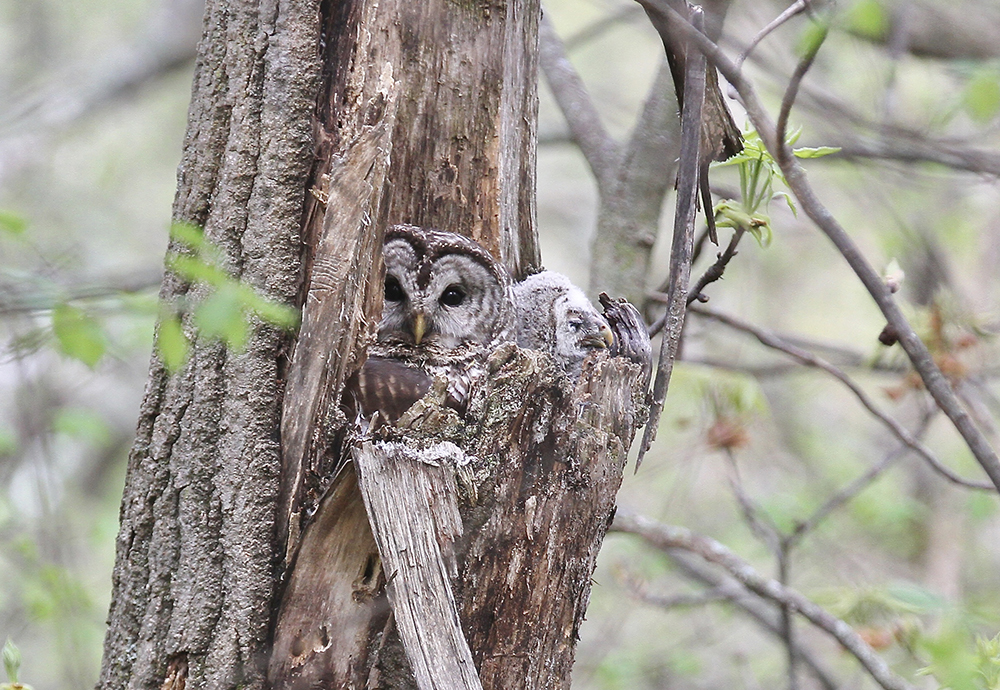
They are a monogamous species, and you may hear mated pairs calling back and forth to each other through the forest (Lewis, 2017). A courting pair will bob their heads, raise their wings, and call to each other. During courtship, males may also offer the female food (Audubon). Barred Owls nest in cavities or abandoned nests of other animals, and do not make their own nests (Cornell University: All About Birds). A female will lay 2-4 eggs early in the year, between March and April (Lewis, 2017). While the female incubates the eggs the male will bring her food. A pair will likely mate for life, and can defend a nesting territory for many years (Cornell University: All About Birds).
Distribution and Habitat
Barred Owls are relatively widespread throughout North America, and as non-migratory birds, individuals rarely leave their established territory unless threatened (Cornell University: All About Birds). Despite this, Barred Owls have managed to increase their range in the northwest over the last few decades. Populations now expand south to northern California and north to the southern Yukon in the Pacific Northwest (Kelly and Forsman, 2004).

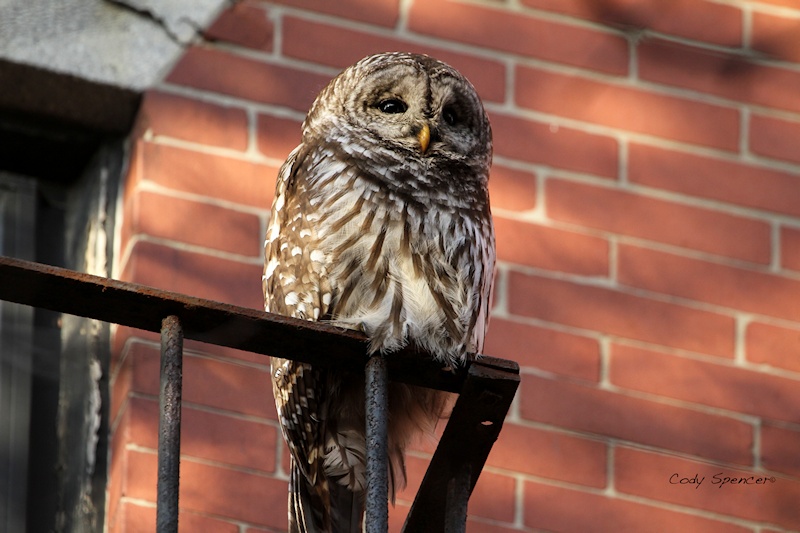
Barred Owls can be found in most woodland areas, but seem to favour unfragmented, mature forests near water (Lewis, 2017). Old Growth forests tend to have trees with large cavities that are ideal for nesting, but many populations have been established in younger forests as well (Long and Wolfe, 2019). They prefer swamps and moist environments that can support their diverse diets, but can adapt to a number of habitats if needed (Lewis, 2017). Although they are generally shy of humans, Barred Owls can be seen in urban areas occasionally.
Conservation
Barred Owls are considered a low concern species with a growing population size. Between 1966 and 2014, Barred Owl populations have risen 1.5% per year (Cornell University: All About Birds). As an adult, their only natural predators are the larger, more aggressive Great Horned Owl (Bubo virginianus) (Cornell University: Birds of North America). They are long-lived, and causes of death are usually due to human activities, either directly through vehicle collisions and hunting or indirectly through habitat loss and fragmentation (Lewis, 2017). Because of their preference for mature forests, Barred Owls are sometimes used as indicator species of old growth habitats by forestry management groups (Cornell University: Birds of North America).

Their spread to the Pacific Northwest has their ranges overlapping with native Spotted Owl (Strix occidentalis) populations (Long and Wolfe, 2019). In many cases, there is evidence that Barred owls out-compete or hybridize with their close cousins the Spotted owl (Hamer et al,, 1994). The displacement of Spotted Owls by Barred Owls is of great concern because Spotted Owls are already considered threatened due to habitat loss (Long and Wolfe, 2019). For this reason, efforts are being taken by wildlife management to control barred owl populations, and plenty of research is being conducted on what makes them so successful.
The Unfortunate Success of the Barred Owl
The expansion and success of Barred Owls in recent years has unfortunately been problematic to less flexible species, like the Spotted Owl. Competition with Barred Owls is currently considered the biggest threat to Spotted Owl populations (Long and Wolfe, 2019). And with increasing global climate, its expected the Barred Owl will continue to expand its range along the Pacific coast and further invade Spotted owl ranges (Audubon). Barred Owls and Spotted Owls are very similar species, so what makes the Barred Owl so successful over its spotted cousin?
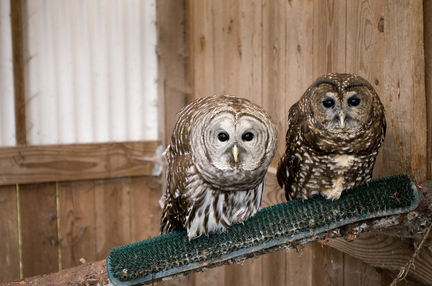
Competition
Recent research has shown that the Barred Owl is often more aggressive in nature than the Spotted Owl (Long and Wolfe, 2019). As a result, Spotted Owls are often bullied out of their territories by Barred Owls. In an experiment using playback tapes and taxidermy mounts, male Barred Owls were found to respond more aggressively to Spotted Owl playbacks and were more likely to attack Spotted Owl mounts (Long and Wolfe, 2019). In comparison, Spotted Owls were less likely to attack or respond to Barred Owl playbacks and mounts. There are few reports of Spotted Owls attacking Barred Owls in the wild, and few observations of aggressive displays between Barred Owls and Spotted Owls in which the Spotted Owl is the dominant aggressor (Long and Wolfe, 2019). The aggression displayed by Barred Owls in response to Spotted Owl calls may result in the suppression of calling in Spotted Owls when exposed Barred Owl calls (Long and Wolfe, 2019). This might interfere with Spotted Owl courtship displays or drive them from their territory entirely.
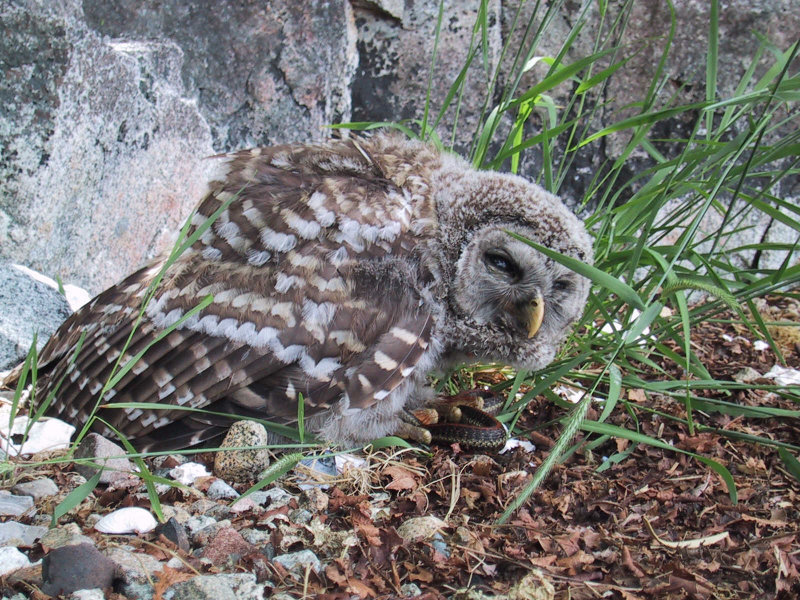
Barred owls have an extensive diet, and will eat most creatures smaller than itself (Lewis, 2017). In comparison, Spotted Owls tend to prey primarily on small mammals, and in some areas they specialize on one main prey source, usually a type of squirrel or woodrat (Cornell University: All About Birds). Because of their picky diet, Spotted Owls can be limited to areas where their prey is abundant. Barred Owls, however, are not nearly as limited. Due to flexibility in their diet, Barred Owls are able to take advantage of many food sources, lending to their success along the West coast (Long and Wolfe, 2019).
Hybridization
Generally, the hybridization of raptors is very rare outside of captivity (Long and Wolfe, 2019). However, there have been reports of hybridization between Barred Owls and Spotted Owls where their ranges overlap. The earliest Barred Owl and Spotted Owl hybridization to be recorded was in 1986 (Long and Wolfe, 2019). Since then, more than 50 hybrids have been reported. While this number may seem inconsequential, hybrids are very difficult to identify and their numbers might be much greater than actually reported (Kelly and Forsman, 2004). The concerns surrounding hybridization is that it may lead to genetic swamping of the Spotted Owl, and eventually lead to a collapse of boundaries between the two species (Long and Wolfe, 2019).
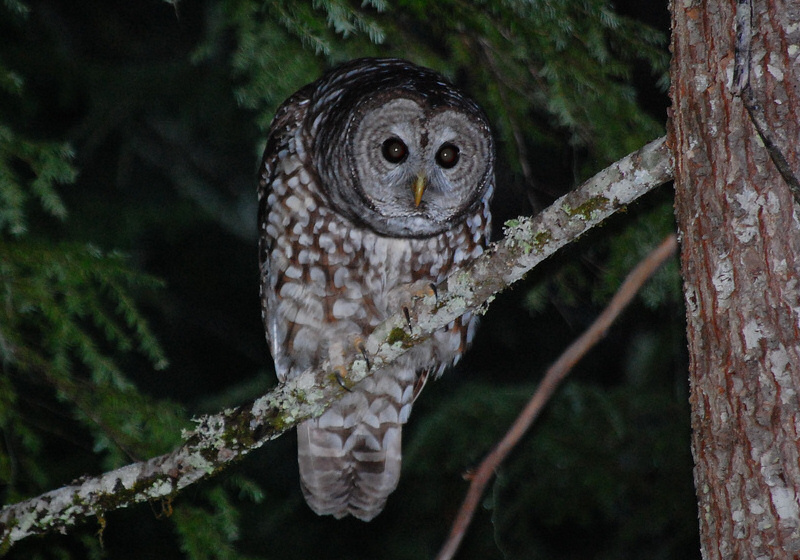
As mentioned previously, hybrids can be difficult to identify. Typically, hybrids have a checkerboard like pattern of brown and white on their chest, with a white barred head more characteristic of a Barred Owl . Coloration of the top of the wings is lighter than the Spotted Owl but darker than the Barred Owl. The facial disks of hybrids resemble those of Barred Owls except with more brown coloration than the Barred Owl’s typical grey face. The hybrids have a unique vocalization that sounds like a mix of both parents. Their calls are longer than those of Spotted Owls, but shorter than Barred Owls, and consist of 5 to 6 hoots. Hybrids are larger than Spotted Owls and similar in size to Barred owls (Hamer et al., 1994).
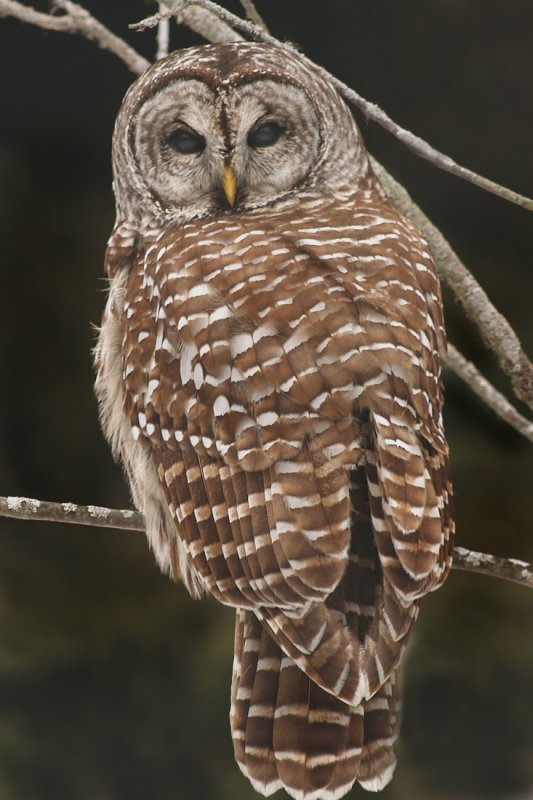
In terms of temperament, hybrids more closely resemble Spotted Owls in that they are docile and less wary of humans than the typical Barred Owl (Hamer et al., 1994). Most hybrids occur between male Spotted Owls and female Barred Owls. One explanation for this is that a female Barred Owl is more likely to accept a meal from a male Spotted Owl because they are less picky eaters, whereas a female Spotted Owl might reject a male Barred Owl if he brings her something she wouldn’t normally eat (Long and Wolfe, 2019).
Parting Thoughts
Barred Owls are magnificent birds. Their resilience and adaptability is remarkable. They are very vocal birds with a large repertoire of sounds which they use to to maintain their territory. However, their flexibility might not be on their side, as they are now seen as a pest in many places in the West because of their displacement of native Spotted Owl populations. Do you think this bird is a menace, or just simply an opportunist?
References
Sibley, D. (2016). Sibley field guide to birds of western North America. New York: Knopf.
Hi Merissa,
Very beautiful and well laid out blog. The media you chose really made this look like a professional blog – very visually appealing! I love these owls. We have a decent number of them in our neighbourhood, so I listen to them while I study! I’ve been practicing my BADO call, and I’ve even gotten one to bird to reply so far (he was probably super irritated)!
It’s pretty crazy how there have been some instances of human attacks by Barred Owls. Having seen those talons up close, I don’t think I’d love those coming after me! Also, I didn’t realize Great-horned Owls would also hunt adult Barred Owls! I thought they went after young birds in the nest more generally. Very interesting!
You mentioned that the Barred Owl invasion is threatening the Spotted Owl. Do you know what efforts are being made to help the Spotted Owls? This is a really an unfortunate circumstance. I appreciate how you ended your blog with a great question for us to think about. I think I would consider the Barred Owl an opportunist, but one could really argue either way.
Thanks for such an informative and well written blog!
Samuelle
Hi Sam,
Thank so much! I’m glad you enjoyed.
I agree that I wouldn’t want one of these big guys coming after me. Apparently just this last month there was a Barred Owl attack at Whistler that got quite a bit of media coverage! Here’s a link to a news article on the incident if you’re interested: https://bc.ctvnews.ca/runners-told-to-avoid-whistler-trail-due-to-aggressive-owl-1.4635099
You’re right in that Great Horned Owls primarily go after BADO nestlings, but there have been cases of GHOWs killing adult BADOs as well! There is also evidence that BADOs will leave their territory all together if they think a GHOW is nearby. Its crazy to think that there is some sort of an owl hierarchy out there.
To answer your question, I believe the primary method of helping the Spotted Owls recover territory from BADOs is unfortunately culling programs. The results of these programs differ from area to area. In some situations, culling BADOs has seemed to improve Spotted Owl populations where in some it doesn’t seem to be an effective method of population control. You could see how these programs might be problematic as well if the people conducting the culls aren’t experienced birders. An untrained eye might mistake SPOW for BADO! Ultimately more research is needed to find if this is an effective way of helping the SPOW.
Thanks again!
Merissa
Hi Merissa,
Barred Owls are very cute, but are definitely very aggressive! Theres an educational BADO named Dexter at the wildlife rehab centre I work at, who needs to taken out of his cage before it’s cleaned. Otherwise, he’s been known to attack the cleaners! We should go owling again and see if we can find some!
It’s unfortunate that Spotted Owls are the target of the Barred Owl’s aggression. Does the BADO show this behaviour toward owl species other than the SPOW, or are they just taking advantage of SPOW’s more timid behaviour?
Thanks,
Sarah
Hi Sarah,
Glad you enjoyed! Dexter sounds like he has a big personality! I agree, we should definitely go owling again before the winter break!
As for other owls, Barred Owls are known to eat most smaller owls. When exposed to Western Screech Owl calls, BADOs are seen to go into “hunting mode”. It seems most owls smaller than Spotted Owls are seen as prey, not as rivals. In contrast, BADOs usually don’t go up against larger owl species, like the Great Horned Owl, and tend to clear out if their territory is threatened by a GHOW! It seems like they know not to mess with someone much larger than themselves.
Thanks for your question!
Merissa
Hi Merissa,
Very interesting read! It’s fun to sometimes root for the bad guy and it’s not hard when they are this stinking cute.
I see you’ve gotten a few questions about the BADO and SPOW relationship but I am thoroughly intrigued by the sparred owls! My question is if this is really a bad thing? Almost seems better that they would mate with the SPOW rather than attack them. If they do have similar temperaments to the SPOW then they surely aren’t as big of a pest as the BADO. Maybe conservation could focus more on mating than culling? Just a theory 🙂
Thanks!
Emma
Hi Emma,
Thanks for the read!
I had the same thought initially when learning about Sparred Owls! I think the main issue scientists are finding with hybridization is genetic swamping. Essentially, they’re worried that the SPOW will cease to exist in nature because it will hybridize with BADOs to the point of extinction! Then, these hybrids will continue to mate with pure BADOs and will sort of “water down” the SPOW genes. That is the extreme case, however, Sparred Owls don’t seem to be replacing SPOWs as of yet.
I like your idea! I think taking advantage of the fact that BADOs and SPOWs will interbreed, unlike so many other species, could be a good point for further conservation research. I don’t think there are any current records of breeding in captivity between the two species, but it could definitely be something to look into at least.
Thanks again!
Merissa
Hi Merissa,
Your blog was a pleasure to read through. I love BADOs and always keep an eye out for them when I walk through the upper trails of Colliery Dam park (they are surprisingly common there)!
In your blog, you mentioned that Barred Owls form life-long mating pairs and can defend a nesting territory for many years. In class, we learned that many birds have special mating displays or “upkeep” behaviours to keep their mate invested in the relationship. Do you know if Barred Owls have any mating rituals, or is it stone-cold relationship?
Thanks,
Jonathan A.
Hi Johnathan,
Thanks for reading! As for your question, BADOs have initial courtship behaviours to establish a new pair that can consist of vocal displays and wing flapping/head bobbing movements. Males may also bring food to the females they are trying to court during courtship. The information on the maintenance of a mate’s pair-bond is limited. From what I could find, a territorial duet preformed by a pair is thought to serve a duel purpose in that it functions primarily as a territorial display to other owls in the area but also has a secondary function in strengthening a pair’s bond. Allopreening, where one bird preens another bird, is also seen in BADOs. Allopreening is most frequently seen between a pair after their nestlings have fledged, and so is thought to strengthen the relationship between mates when they have more “downtime”.
Thanks for the question!
Merissa